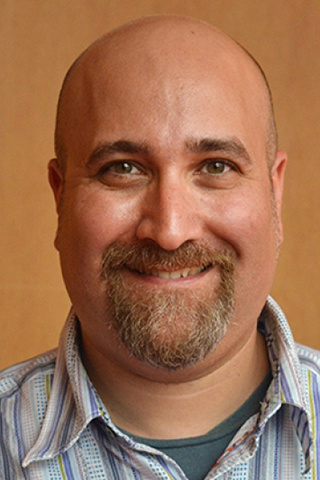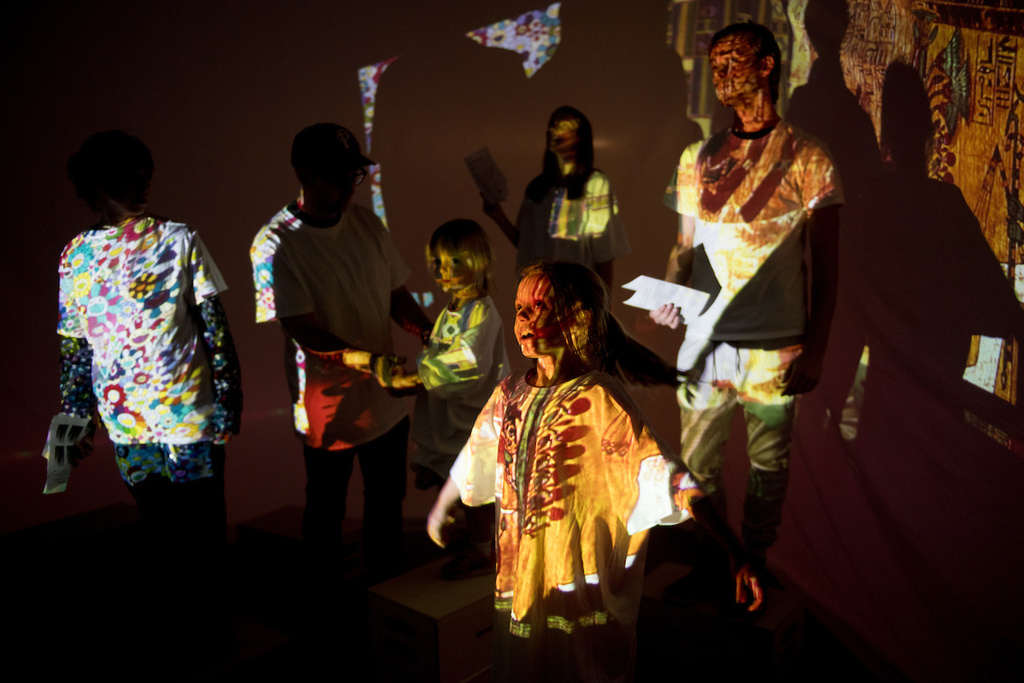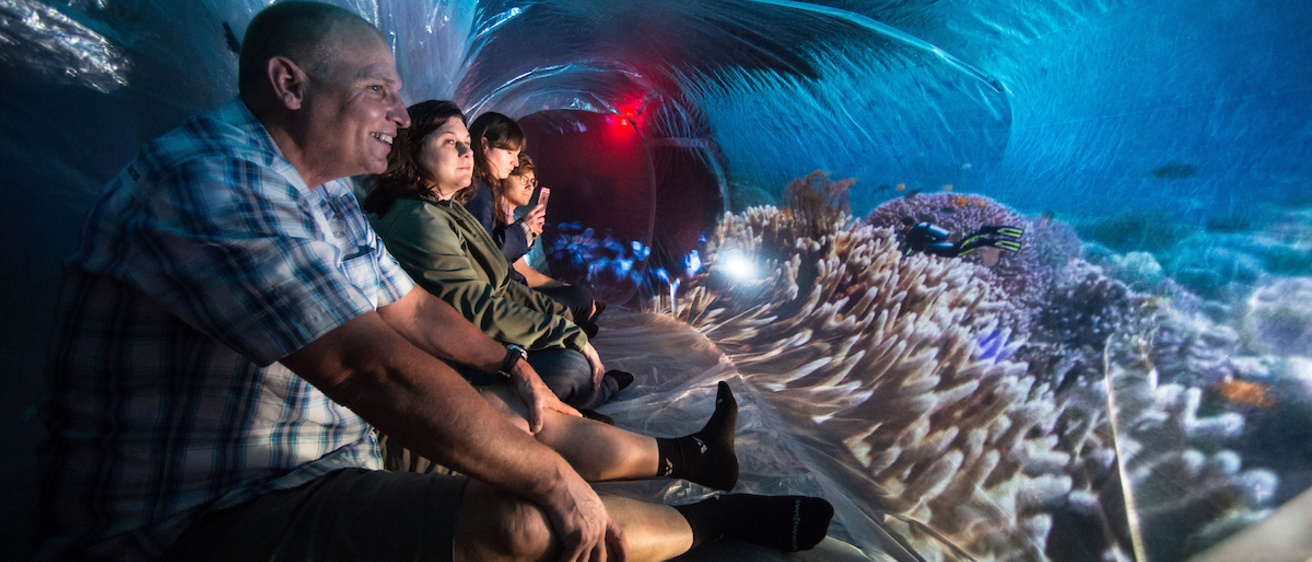The University of Iowa has a long history of fostering creativity and collaboration, building bridges between disciplines and departments to find new ways of doing things. From problem-solving to creating art and entertainment, the UI constantly puts its students in a position to gain new skills and experiences.
One new course offering, cross-listed in the Departments of Theatre Arts and Dance, does just that. Installations and Interactive Performance—taught by Daniel Fine, assistant professor of digital media in performance—is unlike any other class his students have ever taken.
The syllabus describes the course as “An introduction to the aesthetics, techniques and practical possibilities of fusing together theatre, dance, music/sound, art, design, cinema, gaming, human computer interaction, and engineering.”
If that sounds like a lot of cool things mixed together, rest assured—it is.
Students learn the foundations of creating interactive experiences using tools such as digital photos, video, text, objects, live bodies moving in space, sensors, and digital displays.
The class gives students a chance to create interactive performances for their audiences with the use of technology. Adding the technological angle while also staying true to the foundational principles of theater and storytelling is appealing to students across disciplines.

“My main objective when I created the class was thinking about how to make a course that could talk about storytelling and performance with a user-based experience, outside of what we call ‘traditional’ theater and dance,” says Fine. “We were trying to offer students a chance to step outside the conventional narrative, or script-based narrative, and look at how you would create an experience for audience members to participate in while still telling a story, and/or communicating an idea.”
Fine came to the UI as part of the College of Liberal Arts and Sciences’ Public Digital Arts hiring cluster. The goal of that initiative was to commit to innovation and interdisciplinary collaboration in research, teaching, creative work, and the public expression of the university’s creative research and scholarship.
“When I was hired, I was given two tasks in terms of teaching,” says Fine. “One was to create classes that were multidisciplinary and reached out to students across the UI outside of theater arts and dance students. The second was to expand the curriculum for our theater and dance students to integrate new technology into performance.”
Installations and Interactive Performance was taught for the first time during the spring 2017 semester. It attracted students majoring in engineering, computer science, informatics, art, dance, theater, American studies, English, and more. Each student brought different technical and creative skills to the table, making for the exact kind of learning environment Fine sought for this class.
“I’ve found in both my work and the students’ work that when you cross the disciplines and you get right-brained and left-brained thinkers in the room—different people with different views and different skill sets, from different backgrounds—the most interesting work happens,” Fine says.
The students complete four group projects over the semester. Fine refers to each project as “rapid prototyping,” which ends up requiring the entire group to work together while pooling their skills to help execute the task.
Projects can be simple or quite elaborate, so long as they tell a story while at the same time give the audience an experience to interact with. One such project invited its audience to crawl through plastic tunnels interspersed with stations in the form of large bubbles that, through video projected on the bubbles’ walls, told different stories about climate change’s effects on the environment. Another project used motion sensors that projected images onto the participants, making them live art pieces.
The limited time students have to work on each project also forces every group member to participate.
“Every group I was in, there was a moment in the process where each of us talked about what we could do and what we dreamed of doing,” says Sophie Katz, who graduated in the spring of 2017 with degrees in psychology and English and creative writing. “Out of necessity, we had to look at each other and see what was in our individual toolbox.”

The way the class is set up, neither the tech-savvy students nor the performance-minded students have an advantage. They need to work together to create a successful performance or installation.
“I found myself working with people I wouldn’t normally work with who all brought something different,” says Jacob Sikorski, a UI senior from Eldridge, Iowa, who is pursuing degrees in theater and informatics. “For making performances, having people with performance skill sets is very different, but very beneficial.”
While the collection of technical skills is important, finding new ways to engage audiences and tell stories, or even just to think of the possibilities, is equally important.
J.D. Whitman, who is pursuing an MFA in sculpture, says she is taking lessons from the class and applying them to her own work.
“My installation art has always been static, lacking in viewer participation,” she says. “The viewer’s entire involvement started and ended with viewing. This class introduced me to the possibilities of interactive installation art through the use of the software and digital storytelling platforms. The interactive approach augments positive learning through participation.”
For Katz, the class has expanded her view of how stories get told.
“This class got me thinking about having an environment for people to explore and how you get a story out of it,” says Katz, who is applying some of her lessons from the installations class to her position in the Disney College Program in Orlando, Florida. “Usually it’s a person on stage or screen that gives you the story. This idea of people wandering around a building and learning things—they might have a different story experience than anyone else based on the choices they made. You want to create an environment where everyone can get a story out of it.”
That is one of Fine’s primary goals with the class.
“What I try to emphasize is that the technology is a tool for storytelling,” he says. “This doesn’t have to have a beginning, middle, and end, or in that order. It has to be you as an artist, the person creating the experience—what is your message? How do you convey that to the audience?”
By finding ways to tell that story, students from all backgrounds can take with them new ways to approach their disciplines.
“I can’t explain how much this class positively affected my practice and thought process,” says Whitman. “The experience pushed me to break from routine, which is absolutely necessary for self-growth.”

